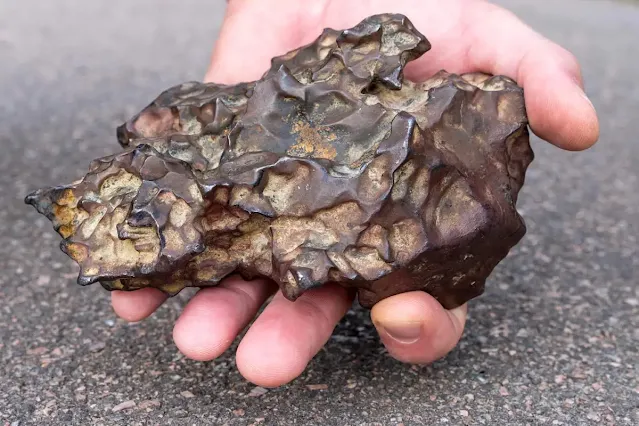Meteorite Identification: How to Identify Meteorites
Have you ever stumbled upon a strange rock and wondered if it could be a meteorite, a piece of space debris that has fallen to Earth! But how can you tell the difference between a space rock and a common rock? Here's a step by step guide to identifying meteorites:
Meteorite is a rock or piece of metal from outer space that survives its passage through Earth's atmosphere and lands on the ground. They can come from asteroids, comets, or even larger objects like planets. Most meteorites originate from the asteroid belt, a region between Mars and Jupiter where millions of rocky objects orbit the Sun.
When a meteoroid (a small piece of rock or metal from outer space) enters Earth's atmosphere, it heats up and glows due to friction with air molecules. This burning object is what we see as a “shooting star” or "falling star" or "meteor." If the meteoroid is large enough, it may not burn up completely and will reach the ground as a meteorite.
Read also: Meteorite Hunting - Where to Find Meteorites in the USA
 |
| Meteorite Identification: Identify Meteorites in 7 Steps. Photo: © Vladimir / Adobe Stock |
Identify Meteorites
Below you will find descriptions of seven different tests you can do to determine if the rock in question is a meteorite.
Observe the Exterior
Fusion crust
When a meteorite is falling through the atmosphere, it begins to heat up because of the extreme compression of the atmosphere. The meteor gets so hot that the outer surface begins to melt, which produces a thin black/brown coating on the surface of the rock called a fusion crust. Iron meteorites may show evidence of melted metal on their surface, but this is less common. Fusion crusts are present on freshly fallen meteorites, but the crusts are fragile and can weather away from samples that fell a long time ago. Small patches of fusion crust can sometimes remain in hollows of the sample. Does your sample have a fusion crust? If so, you have a meteorite.
Regmaglypts
When the surface of the meteorite begins to melt during entry into the atmosphere, some areas of the meteorites are eroded by the melting more than others, almost like someone is taking little scoops of material out. This leaves a bunch of small dents in the surface of the rock, making it look like someone put thumbprints into clay. The surface of most meteorite samples have these thumbprints called “regmaglypts,” which can vary in size from less than a centimeter up to as much as 10 centimeters. Does your sample have Regmaglypt texture/thumbprints? If so, you have a meteorite.
Weathering
Unlike most rocks, meteorites often resist weathering due to their dense composition. Look for sharp edges and minimal erosion.
Feel the Weight
Density: Meteorites typically have a lot of metal tend to be very dense compared to regular rocks. Heft your find in your hand. Does it feel heavier than a rock of similar size?
Do you have something very dense such that it could be a meteorite? But remember that not all meteorites are dense.
Test for Magnetism
Magnetic Properties - A lot of meteorites contain shiny iron-nickel metal grains or consist largely of iron-nickel metal. The iron in the metal attracts a magnet. Is a magnet attracted to the surface of your sample? If so, you might have a meteorite. But remember that a lot of normal rocks on the Earth are also magnetic. So, just because something is magnetic, it doesn't mean that it is a meteorite.
Check for Metal
Most meteorites contain at least some metal. Look for shiny metallic specks within the rock, especially on a freshly broken surface. If so, you might have a meteorite.
Look for Chondrules
Chondrules are tiny, spherical beads of molten rock found in some meteorites. Chondrules: These tiny, round balls of minerals are unique to meteorites and indicate their extraterrestrial origin. Look for them with a magnifying glass.
Some sedimentary and volcanic rocks can have spherical particles that look somewhat like chondrules. Does your sample contain chondrules? If it does, you might have a meteorite.
Examine the Streak
Most meteorites won’t leave a streak, but the surfaces of some meteorites might leave a reddish streak if they have been oxidized (rusted). If you drag your sample across this “streak plate,” and it leaves a red/orange line, then the sample is probably a common mineral on the Earth called hematite. If the sample is magnetic and leaves a black or gray streak, then it might be the common terrestrial iron-oxide mineral called magnetite. Does your sample cause a streak on a “streak plate?” If not, you may have a meteorite.
Seek Expert Help
If you've reached this point and suspect you might have a meteorite, consult a geologist or meteorite expert. They can perform further tests, like chemical analysis, to confirm its origin.



%20(1).webp)





